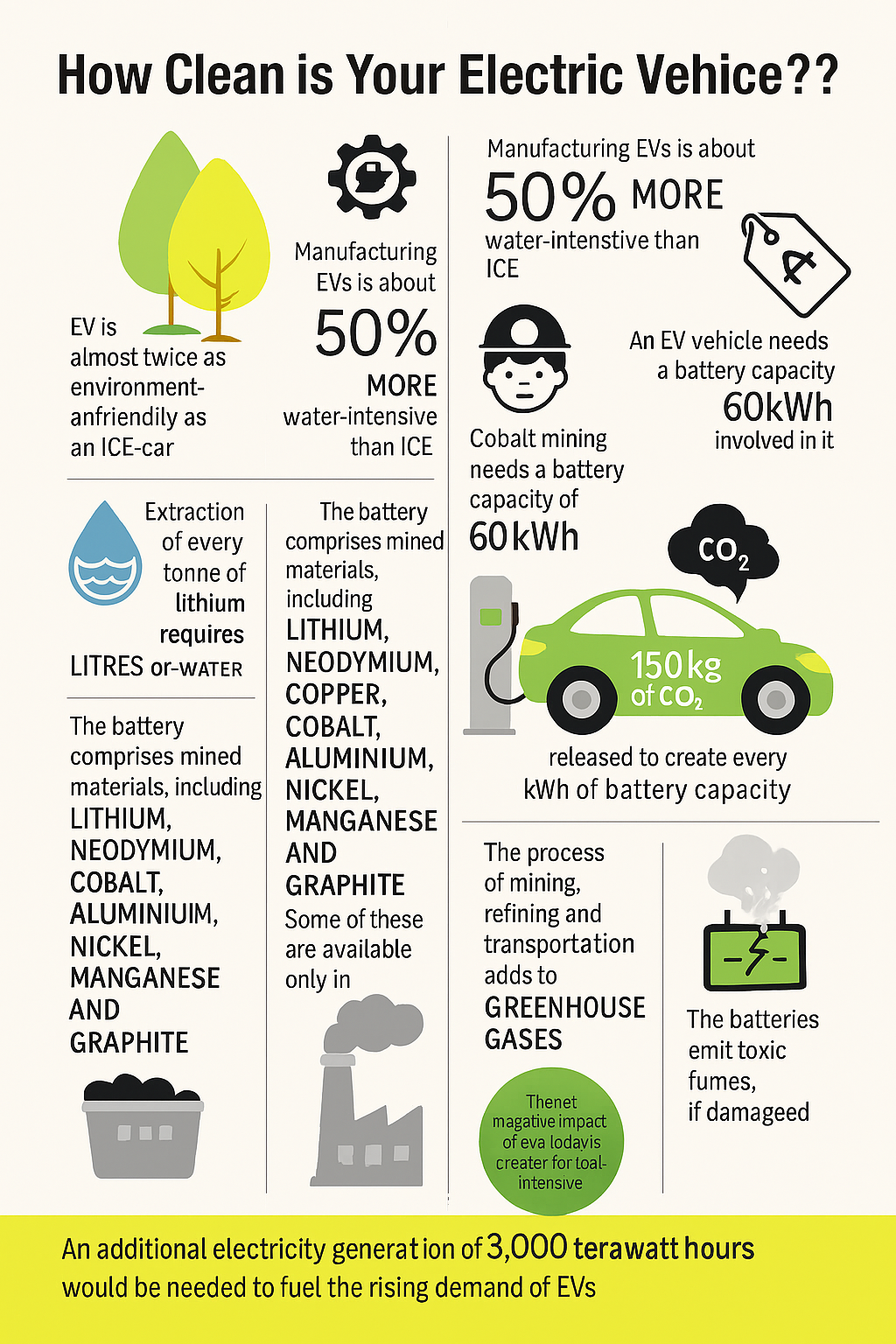The EV Boom Has a Dirty Secret Environmental Costs of Electric Vehicles
Electric Vehicles (EVs) are often celebrated as a key component of India’s clean energy ambitions. However, a closer look reveals that the environmental benefits of EVs are accompanied by significant trade-offs that are not widely discussed. While EVs promise to reduce greenhouse gas emissions, they introduce other environmental challenges that need urgent attention.

Environmental Concerns Regarding EVs
Tyre Microplastic Pollution: EVs are generally 15–20% heavier than internal combustion engine (ICE) vehicles due to their battery packs, which can weigh between 300–900 kg. This additional weight increases tyre wear, leading to higher levels of microplastic pollution. Primary fragmentation, caused by sudden braking or road impacts, releases micro-sized particles into the air, while routine wear produces larger particles that settle on roads and affect soil and water quality. Rapid acceleration in EVs further exacerbates this issue, intensifying microplastic emissions and contributing to air pollution.
Lithium-Ion Battery Hazards: The production of lithium-ion batteries for EVs is a significant source of CO₂ emissions. Manufacturing a single EV battery can release 16–19 tonnes of CO₂, nearly double the emissions from producing an ICE vehicle. Additionally, producing one tonne of lithium requires approximately 1.89 million liters of freshwater, which can strain local water resources and ecosystems. The disposal of EV batteries also poses a challenge, as improper recycling can lead to long-term environmental and health risks due to cobalt and lithium residues.
Grid Dependency and Fossil Fuels: EVs are only as green as the electricity that powers them. In India, where the grid is still dominated by coal, the environmental benefits of EVs are limited. Coal-fired power plants emit significant amounts of CO₂, which offsets the reductions in tailpipe emissions achieved by EVs. Furthermore, many public charging stations rely on diesel generators, which ironically increases emissions.
Gaps in EV Regulation in India
Inconsistent and Fragmented Policy Implementation: India’s current air pollution standards focus on particulate matter (PM) 2.5 and PM10, but they do not adequately address non-exhaust emissions such as tyre and brake wear. The country lacks robust legislation to prevent the illegal dumping of spent lithium-ion batteries, and the existing legal framework is insufficient to manage the expected volume of EV battery waste.
Limited Scope of Government Incentives: Government incentives for EV adoption are primarily focused on urban areas and specific vehicle types, such as 3-wheelers and buses. This leaves rural and semi-urban areas out of the conversation and limits the potential for widespread EV adoption. Additionally, the current charging infrastructure is inadequate, particularly outside metro cities, and there is no national standardization of charging equipment and battery technologies.
Lack of Dedicated Regulatory Authority: There is no single agency or department dedicated to EV regulation and coordination across ministries. This absence of a unified institutional mechanism hampers efficient decision-making, monitoring, and rapid response to industry needs.
Inadequate Focus on Supply Chain Security: India lacks a secure and diversified supply of critical raw materials like lithium, cobalt, and rare earth elements needed for EV batteries. There is no comprehensive national strategy to build domestic reserves, create international partnerships, or incentivize local alternatives.
India’s Key Initiatives to Promote EV Adoption
India has launched several initiatives to promote EV adoption, including the PM E-DRIVE Scheme, the New Electric Vehicle Policy 2024, the Faster Adoption and Manufacturing of Electric Vehicles (FAME) Scheme II, the National Electric Mobility Mission Plan (NEMMP), the National Mission on Transformative Mobility and Battery Storage, the Production Linked Incentive (PLI) scheme, and the Go Electric campaign.
Balancing EV Growth with Environmental Sustainability
To ensure that the EV revolution in India is truly sustainable, the country must adopt a holistic approach that goes beyond electrification:
Promote Green Manufacturing: Encourage EV and battery manufacturing powered by renewable energy. Integrate solar and wind energy with public and private EV charging stations and promote Vehicle-to-Grid (V2G) technologies to balance intermittent renewable sources.
Circular Economy Framework: Implement a robust battery recycling and reuse ecosystem. Establish a “Battery Passport” model to track the carbon footprint and lifecycle of batteries and enhance transparency.
Standardization and Green Supply Chains: Create a National EV Regulatory Authority to coordinate across ministries and incentivize green supply chains. Develop strategic partnerships for ethical sourcing of critical materials.
Consumer Awareness and Demand-Side Management: Launch national campaigns to promote the financial and environmental benefits of EVs. Encourage home-based charging solutions and smart charging incentives to manage grid load.
Urban Planning and Sustainable Mobility Integration: Integrate EV planning with urban development initiatives and promote mixed-use development and non-motorized transport integration.
Carbon Accounting and Environmental Monitoring: Establish a dedicated environmental impact agency for EVs to track carbon emissions, life-cycle impact, and battery disposal. Incorporate EVs into India’s carbon market framework and align EV policies with the country’s Nationally Determined Contributions (NDCs) under the Paris Agreement.
Conclusion
India’s EV revolution presents a unique opportunity to reduce emissions and create a cleaner, more sustainable future. However, to achieve this, the country must address the environmental trade-offs associated with EV adoption and implement a comprehensive strategy that promotes green manufacturing, circular economy principles, and sustainable urban planning. By learning from global leaders and tailoring policies to India’s unique challenges, the country can ensure that its EV revolution is not just electric but also truly green.
Reference
- Government of India. (n.d.). FAME India Scheme Phase II. Ministry of Heavy Industries. https://fame2.heavyindustries.gov.in
- Government of India. (2024). New Electric Vehicle Policy 2024. Ministry of Heavy Industries.
- International Energy Agency. (2023). Global EV Outlook 2023: Catching Up with Climate Ambitions. IEA Publications. https://www.iea.org/reports/global-ev-outlook-2023
- Ministry of Power, Government of India. (n.d.). National Electric Mobility Mission Plan 2020. https://powermin.gov.in
- NITI Aayog. (2021). Battery Waste Management Rules, 2022. Government of India. https://www.niti.gov.in
- The Indian Express. (2023). Environmental trade-offs of electric mobility in India. Retrieved from https://indianexpress.com
- United Nations Framework Convention on Climate Change. (2015). Paris Agreement. https://unfccc.int/process-and-meetings/the-paris-agreement/the-paris-agreement
- European Commission. (2020). EU Battery Regulation and the Battery Passport. https://ec.europa.eu

